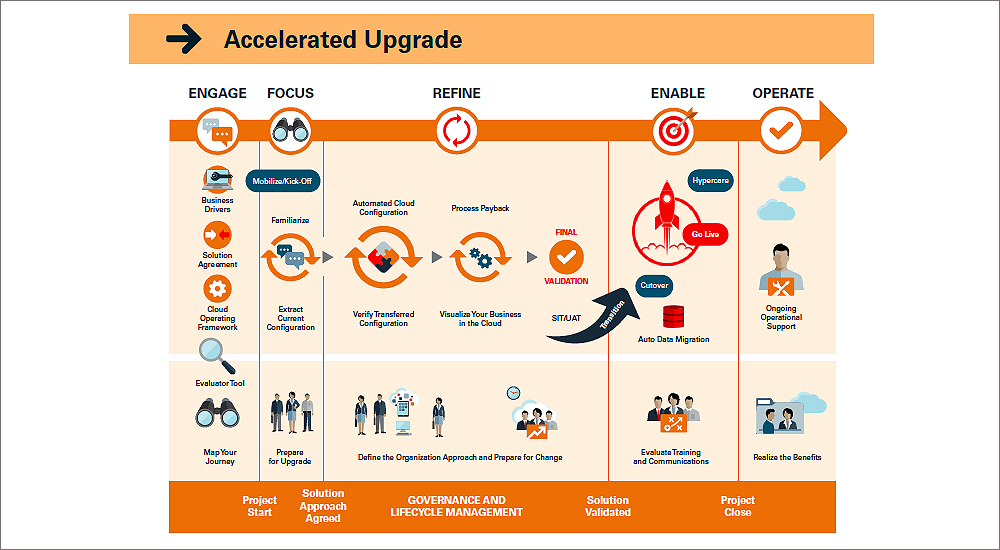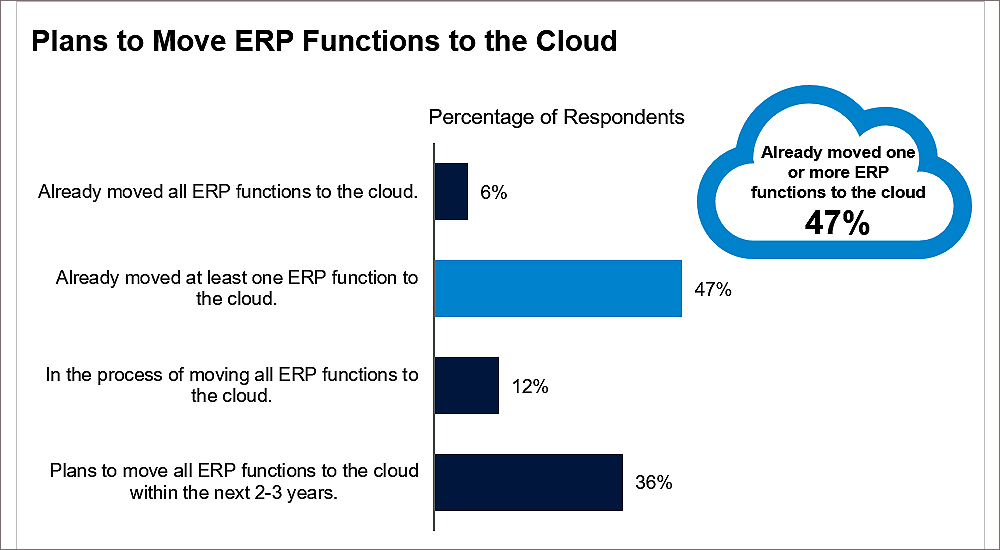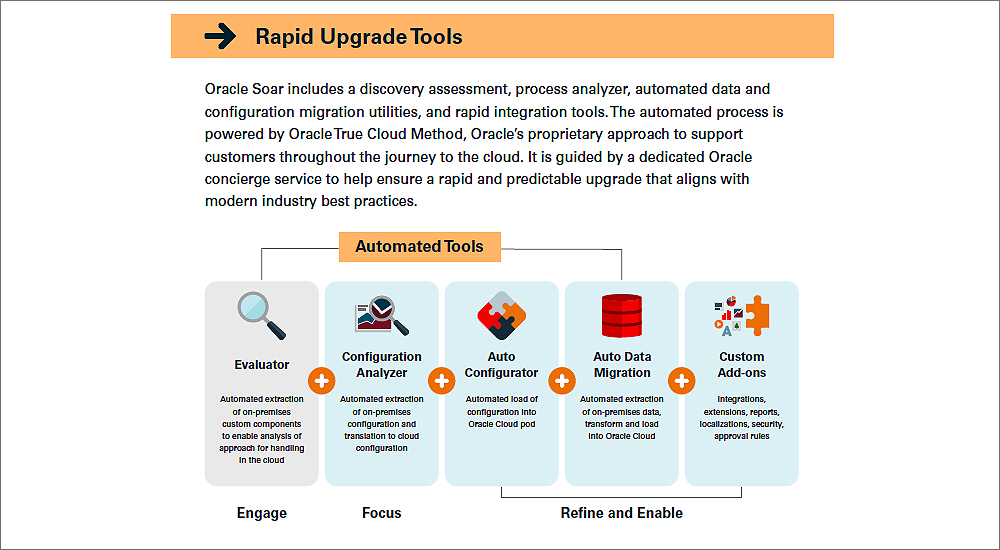Migrating your ERP applications from on-premises to the cloud using Oracle Soar

In June 2018, Oracle announced its Soar to the Cloud offering for accelerating client migration from on-premises Oracle ERP applications to Oracle ERP Cloud. Upgrading an ERP solution for strictly technical reasons may cause more business disruption than benefits delivered. It may also result in a missed opportunity to leverage new capabilities.
Legacy ERP customisations that addressed gaps in functionality may inhibit the effectiveness of moving to a cloud ERP solution, delaying the expected realisation of benefits. Moving all or part of the application portfolio to the cloud stresses traditional file-based, point-to-point integrations, reducing system reliability and increasing maintenance costs.
Most customers using on-premises Oracle ERP applications are not ready for the amount and rate of change that the Oracle Soar offering and Oracle ERP Cloud upgrade program brings. Lack of preparedness can delay and derail an ERP initiative. By 2021, 55% of Oracle’s on-premises customers will have moved 80% of their on-premises capabilities to Oracle Cloud Applications.
Gartner surveys and interactions with customers have shown an increasing movement of on-premises ERP functions to the cloud. In fact, as of October 2018, almost half 47% of recently surveyed Gartner customers have moved one or more ERP functions to the cloud.
Another large percentage of these surveyed customers are in the process of moving their ERP applications to the cloud, or will do so in the next two to three years. Customers are looking at increased speed of delivery as one of the key benefits of cloud ERP.

What is Soar?
The Oracle Soar packaged offering is a combination of conversion tools, data transformation services, training, consulting and support resources to make migration to the Oracle ERP Cloud Applications a relatively hands free process.
Oracle provides tools to first inspect the customer’s database for workflows, organisations, configurations, customisations and chart of accounts. The Oracle tools then map these areas to business processes, financial data models and configurations of the Oracle ERP Cloud Applications.
Oracle estimates about 20 weeks from initiation of the service through data conversion to go-live. Complicating factors to that timeline will be the amount of historical data to be converted and the number of customisations and interfaces that reside in the customer’s ERP system. The fit for customers to this fixed price, fixed scope offering will be determined by the number of customisations.
Oracle has put several years of effort into developing the methodology and programs for converting every table and configuration in Oracle EBS Financials and PeopleSoft Financials into comparable tables and configurations in the Oracle ERP Cloud. This is a significant effort, considering that there is still ongoing investment in the Oracle on-premises ERP solutions.
Oracle Consulting will use the Evaluator tool to evaluate customisations, reports and integrations to determine whether there are comparable features that can be delivered by Oracle ERP Cloud Applications. Oracle Consulting will provide the results to the customer, recommending the specific processes, integrations and features within Oracle ERP Cloud that can replace the customer’s customisations.
Conversely, the package includes 30 integrations and 30 custom reports built by Oracle Consulting that cannot be delivered natively by Oracle ERP Cloud Applications.
The Soar offering provides a dashboard to observe the progress of data conversion, integration and business process building over the course of the 20-week conversion. Included in the package is training in the Oracle Cloud Applications through Oracle University.
Also included is a team of 14 Oracle Consultants to manage the process, run the data migrations, initiate the integrations, and build the extensions that are required. Oracle has set a target for the cost of a Soar conversion as twice the expected Oracle ERP Cloud subscription cost, though this estimate may vary.


Ground reality
The Oracle EBS and PeopleSoft products provided many features for enterprises using them for their ERP systems. Oracle has generally provided many new features every year, via feature packs and updates, while periodically providing major release upgrades.
Due to the unique global needs and regulatory requirements, or even uniquely differentiating and advantageous processes for customers, neither Oracle EBS nor PeopleSoft could accommodate every single feature function needed.
Consequently, both Oracle EBS and PeopleSoft were built to allow invasive customisations, extensions, custom reports and integrations. Customers were able to fulfill their unique needs on their own with the development tools provided by Oracle.
As customers were able to develop customisations to rapidly tailor the systems to their needs, they could then justify further customisations simply on the basis of system ownership. It is extremely rare to encounter an Oracle on-premises ERP customer that has not customised any part of its ERP because of the opportunities for customisation.
The main point, though, is that these customisations were built because organisations needed a function, feature or integration that, at a given time, was not available within the system. Often, these customisations cascade to prevent reverting to delivered functionality when Oracle is able to provide a solution.
The customisations often create a roadblock to the ability to upgrade or intake new features delivered in feature packs or updates. Compounding the matter is that customisations to key objects such as field or table structures often require modifications to delivered integration programs, or entirely new integration programs.
Customers are reporting that they are looking to cloud ERP vendors to deliver increased integration and functional capabilities. In fact, replacing customisation is reported as the second highest requirement when implementing a new ERP solution, with integration capabilities.
If migrating to Oracle ERP Cloud Applications does bring technology advantages that fit into your business strategy, the Oracle Consulting Soar offering may accelerate your time to value by providing conversion cost certainty and a fixed time window for the service.
Soar checklist
- Position your ERP upgrade as an opportunity to provide tools for business transformation.
- Minimise ERP costs by rationalising all customisations.
- Document and evaluate the current business need, and attach a value metric to each customisation.
- Prepare your organisation for the change by adopting a product management philosophy for ERP.
- What is the business value of each customisation in the current ERP?
- How should I adapt my change management policies to prioritise standardised processes?
- What can I do to reduce the technical debt of my current amount of customisations?
- Can my organisation adapt to supporting a SaaS-delivered ERP?
- Does the Oracle Soar offering accelerate delivery of business outcomes?
- Can business and IT absorb the change that comes with changing ERP applications?
- Do the technologies that Oracle provides in its ERP Cloud Applications fit our roadmap?
- Will my organisation need specialised business transformation knowledge from a specific system integrator?
- Evaluate whether your customisations deliver truly differentiating capability prior to Soar?
Key takeaways
- Gartner surveys and interactions with customers have shown an increasing movement of on-premises ERP functions to the cloud.
- Customers are looking at increased speed of delivery as one of the key benefits of cloud ERP.
- By 2021, 55% of Oracle’s on-premises customers will have moved 80% of their on-premises capabilities to Oracle Cloud Applications.
- Customisations were built because organisations needed a function, feature or integration that, at a given time, was not available within the system.
- These customisations cascade to prevent reverting to delivered functionality when Oracle is able to provide a solution.
- The customisations often create a roadblock to the ability to upgrade or intake new features delivered in feature packs or updates.
- Customisations to key objects such as field or table structures often require modifications to delivered integration programs.
- Customers are reporting that they are looking to cloud ERP vendors to deliver increased integration and functional capabilities.
- Replacing customisation is reported as the second highest requirement when implementing a new ERP solution, with integration capabilities.
- Oracle Soar offering may accelerate your time to value by providing conversion cost certainty and a fixed time window for the service.
Source: Adapted and excerpted from 4 Things You Need to Know Before Soaring to the Cloud With Oracle ERP Applications, December 2018, Gartner.





